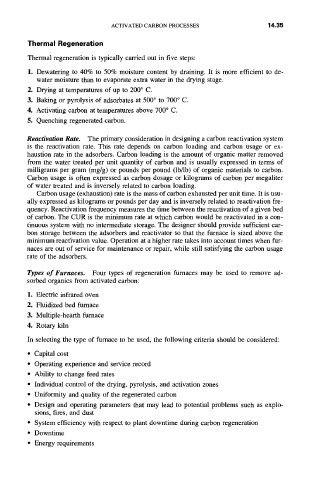Page 487 -
P. 487
ACTIVATED CARBON PROCESSES 14.35
Thermal Regeneration
Thermal regeneration is typically carded out in five steps:
1. Dewatering to 40% to 50% moisture content by draining. It is more efficient to de-
water moisture than to evaporate extra water in the drying stage.
2. Drying at temperatures of up to 200 ° C.
3. Baking or pyrolysis of adsorbates at 500 ° to 700 ° C.
4. Activating carbon at temperatures above 700 ° C,
5. Quenching regenerated carbon.
Reactivation Rate. The primary consideration in designing a carbon reactivation system
is the reactivation rate. This rate depends on carbon loading and carbon usage or ex-
haustion rate in the adsorbers. Carbon loading is the amount of organic matter removed
from the water treated per unit quantity of carbon and is usually expressed in terms of
milligrams per gram (mg/g) or pounds per pound (lb/lb) of organic materials to carbon.
Carbon usage is often expressed as carbon dosage or kilograms of carbon per megaliter
of water treated and is inversely related to carbon loading.
Carbon usage (exhaustion) rate is the mass of carbon exhausted per unit time. It is usu-
ally expressed as kilograms or pounds per day and is inversely related to reactivation fre-
quency. Reactivation frequency measures the time between the reactivation of a given bed
of carbon. The CUR is the minimum rate at which carbon would be reactivated in a con-
tinuous system with no intermediate storage. The designer should provide sufficient car-
bon storage between the adsorbers and reactivator so that the furnace is sized above the
minimum reactivation value. Operation at a higher rate takes into account times when fur-
naces are out of service for maintenance or repair, while still satisfying the carbon usage
rate of the adsorbers.
Types of Furnaces. Four types of regeneration furnaces may be used to remove ad-
sorbed organics from activated carbon:
1. Electric infrared oven
2. Fluidized bed furnace
3. Multiple-hearth furnace
4. Rotary kiln
In selecting the type of furnace to be used, the following criteria should be considered:
• Capital cost
• Operating experience and service record
• Ability to change feed rates
• Individual control of the drying, pyrolysis, and activation zones
• Uniformity and quality of the regenerated carbon
• Design and operating parameters that may lead to potential problems such as explo-
sions, fires, and dust
• System efficiency with respect to plant downtime during carbon regeneration
• Downtime
• Energy requirements

